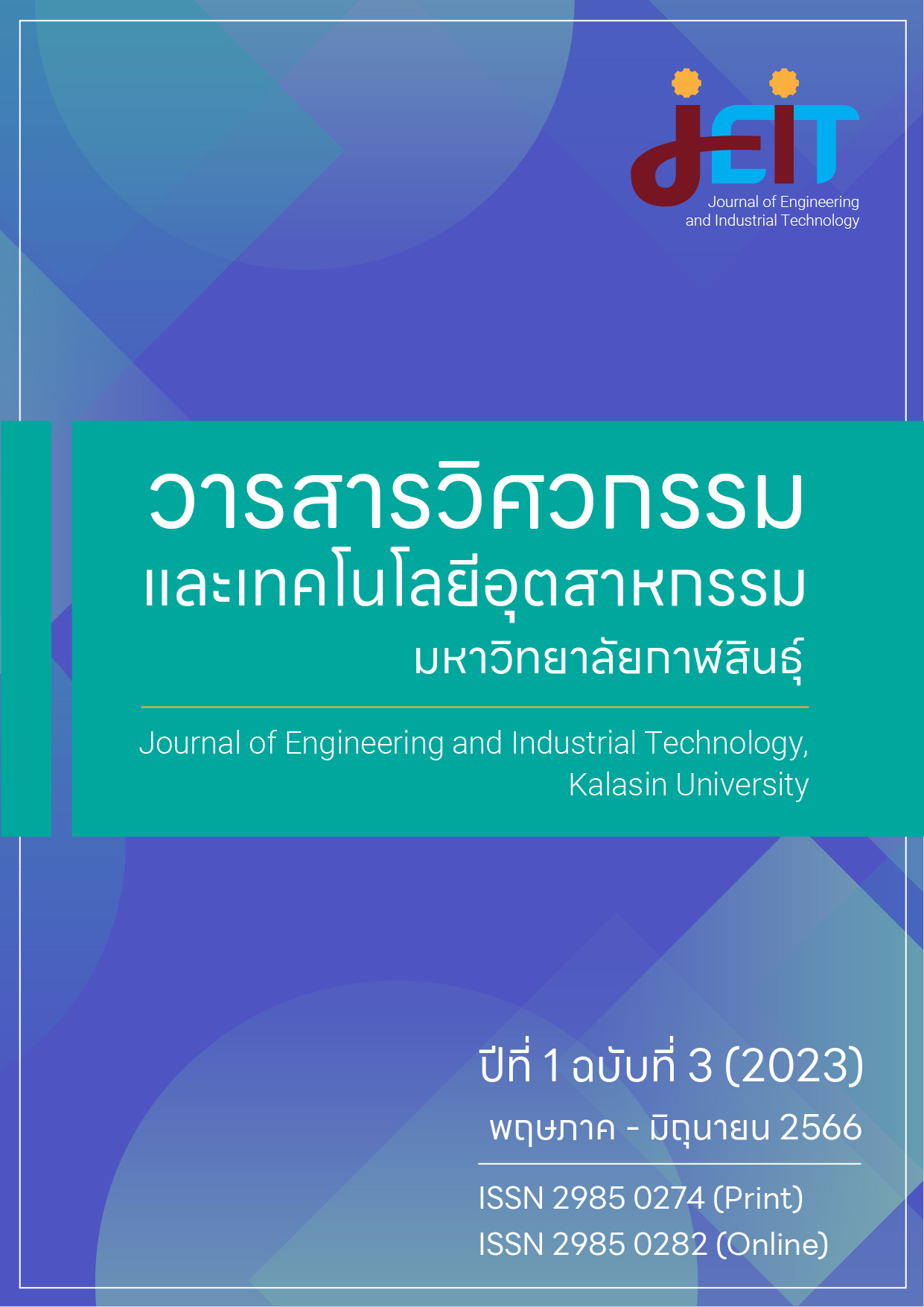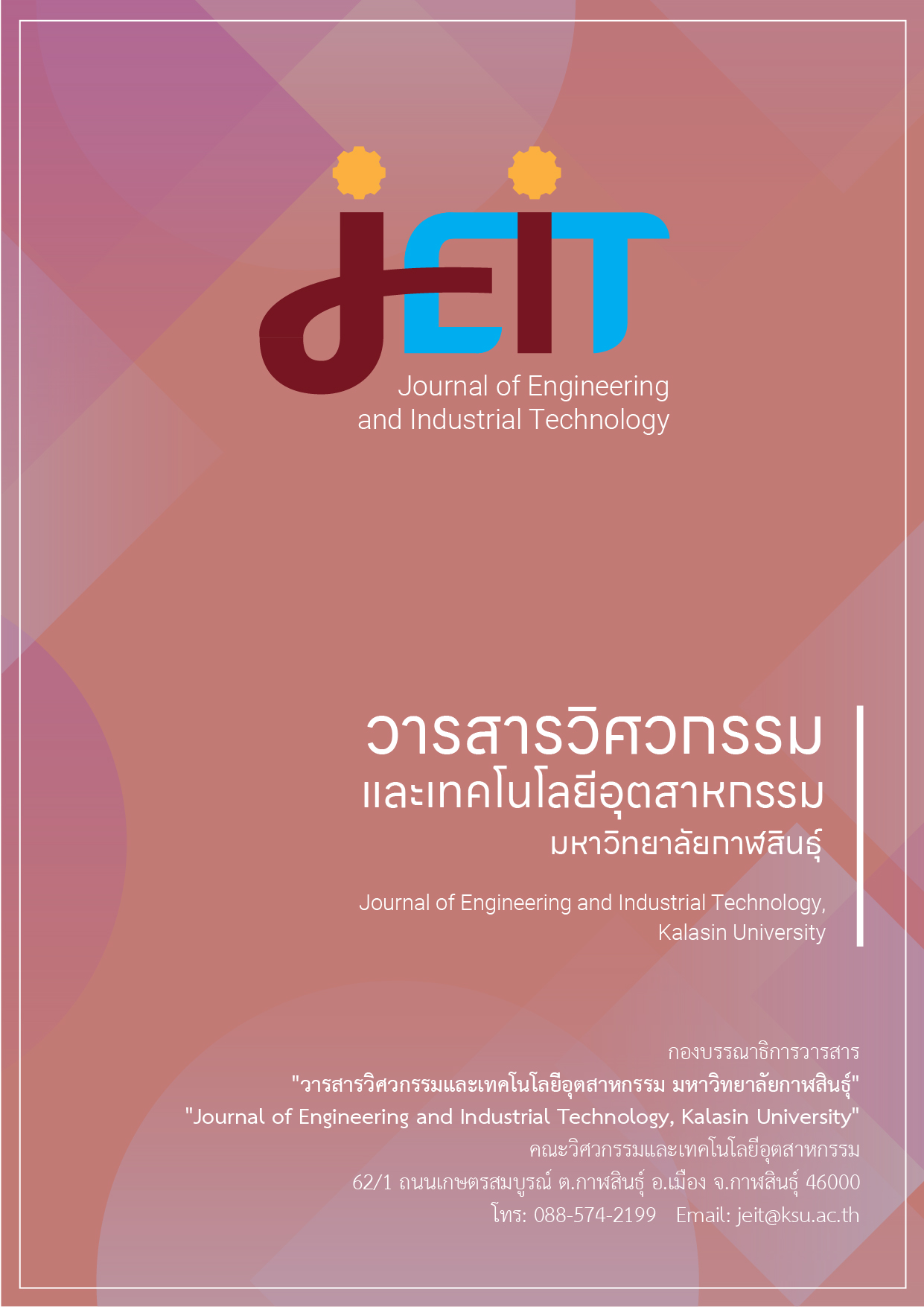การลดคุณลักษณะสำหรับการจำแนกความคิดเห็นบนเครือข่ายสังคมออนไลน์โดยการใช้รูปแบบข้อมูลแนวตั้ง
DOI:
https://doi.org/10.14456/jeit.2023.12คำสำคัญ:
การลดคุณลักษณะ, การจำแนกความคิดเห็น, เครือข่ายสังคมออนไลน์, รูปแบบข้อมูลแนวตั้งบทคัดย่อ
งานวิจัยนี้ ทำการพัฒนาขั้นตอนวิธีในการลดคุณลักษณะ โดยไม่ก่อให้เกิดการสูญเสียคุณลักษณะที่ส่งผลต่อการจำแนก เพื่อนำไปสู่การลดเวลาในการประมวลผลและเพิ่มประสิทธิภาพความถูกต้องการจำแนกความคิดเห็นที่อยู่บนเครือข่ายสังคมออนไลน์ โดยทำการเปรียบเทียบการลดคุณลักษณะโดยการใช้รูปแบบข้อมูลแนวตั้งกับการลดคุณลักษณะด้วยวิธีการไคสแคว์ จำแนกความคิดเห็นด้วยวิธีการนาอีฟเบย์ (Naïve Bayes) ข้อมูลที่ใช้ในการวิจัยรวบรวมจาก Stanford Twitter Sentiment Data ผลการวิจัยพบว่า วิธีการลดคุณลักษณะโดยการใช้รูปแบบข้อมูลแนวตั้งมีประสิทธิภาพดีที่สุด โดยมีค่าความถูกต้องในการจำแนก เท่ากับ 72.64%
เอกสารอ้างอิง
[1] C. Troussas, M. Virvou, K. Junshean Espinosa, K. Llaguno, and J. Caro, "Sentiment analysis of Facebook statuses using Naive Bayes classifier for language learning," in Information, Intelligence, Systems and Applications (IISA),Fourth International Conference, 2013, pp. 1-6.
[2] M. Anjaria and R. M. R. Guddeti, "Influence factor based opinion mining of Twitter data using supervised learning," in Communication Systems and Networks (COMSNETS), 2014 Sixth International Conference, 2014, pp. 1-8.
[3] A. Ortigosa, J. M. Martín, and R. M. Carro, "Sentiment analysis in Facebook and its application to e-learning," Computers in Human Behavior, vol. 31, pp. 527-541, 2014.
[4] S. Aslam. "Twitter Statistics [omincore-agency.com]." [Online]. Available: https://www.omnicoreagency.com/twitter-statistics/. [Accessed: 1 March 2020].
[5] H. Saif, Y. He, and H. Alani, "Alleviating data sparsity for Twitter sentiment analysis," in Making Sense of Microposts (#MSM2012): Big things come in small packages at the 21st International Conference on the World Wide Web (WWW'12), Lyon, France, 2012.
[6] A. A. G. M. Karamibekr, "Sentiment Analysis of Social Issues," in International Conference on Social Informatics, Canada, 2012, pp. 215-221.
[7] J. Yang, Y. Liu, X. Zhu, Z. Liu, and X. Zhang, "A new feature selection based on comprehensive measurement both in inter-category and intra-category for text categorization," Inf. Process. Manage, vol. 48, pp. 741-754, 2012.
[8] Q. Song, J. Ni, and G. Wang, "A Fast Clustering-Based Feature Subset Selection Algorithm for High-Dimensional Data," IEEE Trans. on Knowl. and Data Eng., vol. 25, pp. 1-14, 2013.
[9] S. Das, "Filters, Wrappers and a Boosting-Based Hybrid for Feature Selection," in the Proceedings of the Eighteenth International Conference on Machine Learning, 2001.
[10] J. C. Hall, "A Linguistic Model for Improving Sentiment Analysis Systems," Master of ScienceThesis, North Dakota State University, Fargo, North Dakota, 2014.
[11] B. Liu, Sentiment Analysis and Opinion Mining. Morgan & Claypool Publishers, 2012.
[12] เอกสิทธิ์ พัชรวงศ์ศักดา, การวิเคราะห์ข้อมูลด้วยเทคนิคดาต้า ไมน์นิง เบื้องต้น, 1 ed. กรุงเทพฯ:: เอเชีย ดิจิตอลการพิมพ์, 2557.
[13] A. Go, L. Huang, and R. Bhayani, Twitter sentiment analysis. 2009.
ดาวน์โหลด
เผยแพร่แล้ว
รูปแบบการอ้างอิง
ฉบับ
ประเภทบทความ
หมวดหมู่
สัญญาอนุญาต
ลิขสิทธิ์ (c) 2023 วารสารวิศวกรรมและเทคโนโลยีอุตสาหกรรม มหาวิทยาลัยกาฬสินธุ์

อนุญาตภายใต้เงื่อนไข Creative Commons Attribution-NonCommercial-NoDerivatives 4.0 International License.
ลิขสิทธิ์ของวารสาร
เนื้อหาและข้อมูลในบทความที่ลงตีพิมพ์ในวารสารศูนย์ดัชนีการอ้างอิงวารสารไทย ถือเป็นข้อคิดเห็นและความรับผิดชอบของผู้เขียนบทความโดยตรงซึ่งกองบรรณาธิการวารสาร ไม่จำเป็นต้องเห็นด้วย หรือร่วมรับผิดชอบใด ๆ
บทความ ข้อมูล เนื้อหา รูปภาพ ฯลฯ ที่ได้รับการตีพิมพ์ในวารสารศูนย์ดัชนีการอ้างอิงวารสารไทย ถือเป็นลิขสิทธิ์ของวารสารศูนย์ดัชนีการอ้างอิงวารสารไทย หากบุคคลหรือหน่วยงานใดต้องการนำทั้งหมดหรือส่วนหนึ่งส่วนใดไปเผยแพร่ต่อหรือเพื่อกระทำการใด จะต้องได้รับอนุญาตเป็นลายลักอักษรจากวารสารศูนย์ดัชนีการอ้างอิงวารสารไทยก่อนเท่านั้น



